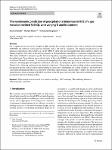Item Infomation
Full metadata record
| DC Field | Value | Language |
|---|---|---|
| dc.contributor.author | Schroeder, Nina | - |
| dc.contributor.author | Rhode, Michael | - |
| dc.contributor.author | Kannengiesser, Thomas | - |
| dc.date.accessioned | 2023-08-17T08:16:17Z | - |
| dc.date.available | 2023-08-17T08:16:17Z | - |
| dc.date.issued | 2023 | - |
| dc.identifier.uri | https://link.springer.com/article/10.1007/s40194-023-01550-2 | - |
| dc.identifier.uri | https://dlib.phenikaa-uni.edu.vn/handle/PNK/8818 | - |
| dc.description | CC-BY | vi |
| dc.description.abstract | For a significant increase in the strength of high-strength fine-grained structural steels with a nominal yield strength ≥690 MPa, the addition of microalloying elements such as Nb and Ti is required. The standard specifications for the chemical composition of these steels (e.g., in EN 10025-6) often only give the manufacturer limit contents to achieve the defined properties. The effect of the alloying elements in the heat affected zone (HAZ) is sometimes completely contrary. This makes it difficult to adequately predict the batch dependency regarding weldability and the load-bearing behaviour of the welded joint. Three different micro-alloyed steels of the grade S690QL were produced on a laboratory scale, focusing on different Nb and Ti contents. | vi |
| dc.language.iso | en | vi |
| dc.publisher | Springer | vi |
| dc.subject | HAZ) | vi |
| dc.subject | grade S690QL | vi |
| dc.title | Thermodynamic prediction of precipitations behaviour in HAZ of a gas metal arc welded S690QL with varying Ti and Nb content | vi |
| dc.type | Book | vi |
| Appears in Collections | ||
| OER - Khoa học Vật liệu, Ứng dụng | ||
Files in This Item:

